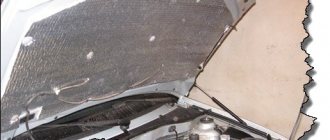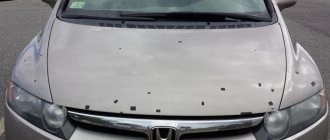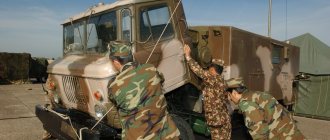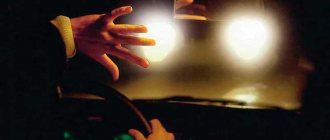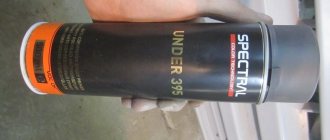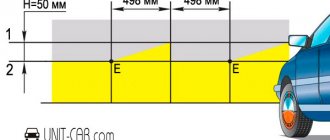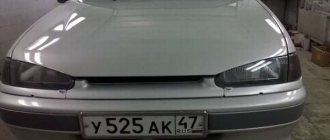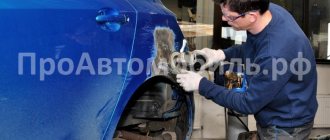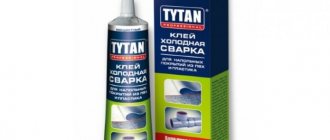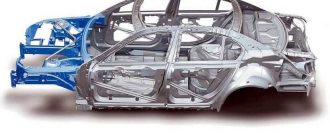Many car owners have to deal with such a problem as dents on their cars. The most common cause of their occurrence is a collision with an obstacle. And the biggest headache is caused by traffic accidents with another vehicle, as a result of which some elements of the body are severely crushed. And then the need for straightening arises.
Inspection of the dent - the initial stage of self-straightening
How to learn how to straighten a car correctly? When starting work, the first thing you need to do is inspect the dent. If it is not very deep, does not have sharp creases and the layer of paint or varnish is not damaged, it does not make sense to use traditional body straightening, since the paintwork will be damaged in the process and the car will have to be repainted, which will entail not only additional material costs, but also a lot of wasted time.
Dent straightening tool
The classic technology of straightening a car body has undergone many changes during its existence, and now the days when it was carried out with just a hammer have sunk into oblivion. Straightening a car body with your own hands is a difficult process that requires a responsible approach, special skills and professional tools.
You can purchase the tool in auto stores or on the market. It contains straightening rubber and pneumatic hammers of various shapes and sizes, various straightening tools, and impact blades. You may also need a jack to straighten sharp creases in the metal. Devices for straightening dents can also be made with your own hands, but for this you need to have sufficient knowledge and skills.
Let's take a closer look at the most commonly used types of straightening tools.
- Percussion instruments: hammers, mallets. Their purpose is to level out dents. The differences between straightening hammers and metalworking hammers are significant. The working head must have a rounded surface and be well polished. The opposite side of the hammers is usually made in the shape of a beak. Materials used for the manufacture of straightening hammers are non-ferrous metals, plastic, rubber, textolite. Thanks to this, the surface of the dent being repaired is less deformed, and the striker itself springs back upon impact. Do-it-yourself body straightening mallets are usually made of hard wood or rubber.
- Anvils, stamps, supports. These devices are needed to support the straightened area of the body. They should be shaped like a dent, which is why there are quite a lot of them in a professional set. A straightening hammer and anvil should always be used in pairs. The main thing is to choose the right backing stamp; it is necessary to take into account the radius of curvature of the surface, the weight and size of the support. To straighten a car with your own hands, you can also use improvised objects, the main thing is to carefully select them for a specific flaw in the body. These can be hammers, iron plates, sledgehammers, etc.
- Impact blades, spoons. These devices are used to pull out the dent. They can also be used as supports. One of the most common cases of their use when straightening a car is to separate the outer surface of a body element from the inner panel, for example for a door. If two of its surfaces collapsed during an accident, then before straightening the door with your own hands, you will have to separate the outer surface from the inner surface with a straightening spoon. Spoons are also often used to straighten the roof of a car and internally correct the curvature of a body element.
- Levers and hooks. They are used if it is necessary to pull out a dent from the inside, relying on any stiffener as a lever. There are also a large number of hooks, they differ in size, metal thickness, and bend angle. You can make a hook for straightening a car yourself, using a metal rod with a diameter of 10-12 mm. Its length should not exceed 0.5 m. The bending angle depends on the geometry of the dent itself. The handle of the hook must be made into a loop so that, if necessary, a device for scrolling can be inserted into it.
- Grinding tools – files, grinder. They are used for grinding a body element that has been leveled after straightening and for leveling small bulges. If you don’t have a grinder, in a garage environment you can use an emery wheel attached to an electric drill.
Types of damage and malfunctions
When restoring a body part, the master has to deal with such problems as:
- Chips, scratches. Defects in the paintwork of a body element are formed due to mechanical stress, due to improper painting technology for the part.
- Damage to paintwork. The paint may peel and fall off. The reasons for the problem include the use of low-quality paint and non-compliance with painting the surface of the body element.
- The appearance of corrosion and rot. A surface poorly treated with anti-corrosion coating becomes covered with rust. This spoils the appearance of the car and leads to the destruction of the body part, as the affected area begins to rot over time.
- Dents and bends. The causes of this type of damage are strong mechanical impact on any part of the body part. The defect occurs after snowballs fall on the hood as a result of careless driving or an accident.
The driver can independently repair damage to the hood, which will save money and get an acceptable repair result.
How to pull out a dent on the hood with your own hands
If you drive carelessly, dents, scratches, chips and cracks appear on the car body. They negatively affect the appearance of the vehicle. One of the parts most susceptible to damage is the hood. In winter, icicles or snow falling from the roof may fall on it, leaving damage and dents. In summer, the body element is easily scratched by branches. Once the damage is done, the hood needs to be repaired.
Types of damage and malfunctions
When restoring a body part, the master has to deal with such problems as:
- Chips, scratches. Defects in the paintwork of a body element are formed due to mechanical stress, due to improper painting technology for the part.
- Damage to paintwork. The paint may peel and fall off. The reasons for the problem include the use of low-quality paint and non-compliance with painting the surface of the body element.
- The appearance of corrosion and rot.
A surface poorly treated with anti-corrosion coating becomes covered with rust. This spoils the appearance of the car and leads to the destruction of the body part, as the affected area begins to rot over time. - Dents and bends. The causes of this type of damage are strong mechanical impact on any part of the body part. The defect occurs after snowballs fall on the hood as a result of careless driving or an accident.
The driver can independently repair damage to the hood, which will save money and get an acceptable repair result.
Types of jobs
To straighten dents, carry out the following work:
- Dismantling of the work site.
- Degreasing the working surface, removing dirt, removing the anti-corrosion coating and soundproofing layer.
- Straightening the hood
- Sanding, priming and painting the previously damaged area.
- Installing the part in place.
Straightening tool
In order to straighten a dent, you will need:
- Percussion tools - metal and rubber hammers, reverse hammer.
- Anvils, dies, supports, impact pads.
- Construction hair dryer, gas torch or blowtorch. Using the equipment, the body part is heated, which subsequently helps to effectively get rid of the dent.
- Grinder, welding machine. In some cases, the damaged area is removed and a patch is welded in its place.
- Brushes of different sizes, sanding machine. After the work, it is necessary to restore the hood to its original form. To do this, the corrected area is treated with putty, sanded and a paint coating is applied to it.
How to level the hood
You can do car hood repairs yourself. To remove dents, you will need to follow the procedure for leveling the body part with your own hands:
- You will need to prepare the necessary set of tools. The set of necessary tools includes metal and rubber hammers, spoons, a file, a sander (in some cases, a sanding disc connected to a drill will do), hooks and levers, degreaser, rags, primer and paint.
Stamps, anvils, substrates, spoons, supports largely repeat the outline of the defect. Using the right tool greatly simplifies the work process. When using hammers, strike frequently and lightly.
How to straighten or straighten a hood
In order not to overpay at a car service center, it is important to know how to straighten the hood of a car yourself. To complete this work, you will need to do the following:
- Carefully inspect the damaged area, determine the severity and nature of the damage.
- If the damage is a dent with metal bends and deep depressions, use a straightening hammer and anvil.
- Deep defects are corrected by stretching the metal and then removing excess parts.
- If the hood is severely damaged, then the worn-out piece of metal is removed and a new one is welded in its place. Subsequently, the weld is ground, the irregularities are covered with putty, primed and painted.
- In some cases, it is not possible to remove the damaged body element. In this case, use a special spoon to straighten the dent.
It is recommended to perform straightening corrections according to the following algorithm:
- Initially, general straightening is carried out: the dent is straightened. Afterwards, they begin to work out the damage in detail: level the working surface, remove minor defects.
- Large dents are repaired progressively from the edge of the damaged area to its center.
- A small defect is eliminated, on the contrary: from the center to the edges.
- To achieve tightening of the metal, cover the damaged area with a wet rag and then heat it with a blowtorch or gas torch. Next, the heated area is cooled sharply. Due to the temperature difference, the metal contracts. Wet rags are needed to protect undamaged areas of the hood from heat.
If the defect is not corrected in a timely manner, corrosion may form at the site of damage to the hood, which will subsequently affect entire parts of the body part. Therefore, you should not hesitate to carry out repair work.
After restoring the body element, the paintwork will be damaged. You should also take care to level the work area. To do this, it is primed and sanded. When a positive result is achieved, the surface is painted and an anti-corrosion coating is applied.
Useful tips
When straightening a body element, you should follow some recommendations:
- Minor damage should be repaired by hand, without using straightening tools. On the hood of the car, thin metal is used, after manual straightening, there will be no trace of damage, and the motorist will save time and money (there is no need to buy a spray gun, a can of paint, brushes, primer and degreaser). In addition, the use of grinding wheels and files will not be required.
- After priming and subsequent polishing, you will need to run your hand over the working surface; this step will reveal unevenness. In places where a perfectly even coating is required, use a ruler.
- It is also necessary to remember that excessive heating of the hood can negatively affect the paintwork of the part. To prevent damage to the paint, do not heat the body element to a temperature above 110 degrees Celsius.
Source: https://litezona.ru/kak-vytjanut-vmjatinu-na-kapote-svoimi-rukami/
Straightening tool
In order to straighten a dent, you will need:
- Percussion tools - metal and rubber hammers, reverse hammer.
- Anvils, dies, supports, impact pads.
- Construction hair dryer, gas torch or blowtorch. Using the equipment, the body part is heated, which subsequently helps to effectively get rid of the dent.
- Grinder, welding machine. In some cases, the damaged area is removed and a patch is welded in its place.
- Brushes of different sizes, sanding machine. After the work, it is necessary to restore the hood to its original form. To do this, the corrected area is treated with putty, sanded and a paint coating is applied to it.
How to level the hood
You can do car hood repairs yourself. To remove dents, you will need to follow the procedure for leveling the body part with your own hands:
- You will need to prepare the necessary set of tools. The set of necessary tools includes metal and rubber hammers, spoons, a file, a sander (in some cases, a sanding disc connected to a drill will do), hooks and levers, degreaser, rags, primer and paint.
Stamps, anvils, substrates, spoons, supports largely repeat the outline of the defect. Using the right tool greatly simplifies the work process. When using hammers, strike frequently and lightly.
How to straighten a body, video
Any, even the most imperceptible change in the geometry of the body - doorways, main diagonals, control distances between the base points on the car body, leads not only to a waste of time on straightening the body panels, but also reduces the strength of the power frame of the car body. Do-it-yourself body straightening, the video of the process shown below, should not be taken as a guide to action.
How to straighten or straighten a hood
In order not to overpay at a car service center, it is important to know how to straighten the hood of a car yourself. To complete this work, you will need to do the following:
- Carefully inspect the damaged area, determine the severity and nature of the damage.
- If the damage is a dent with metal bends and deep depressions, use a straightening hammer and anvil.
- Deep defects are corrected by stretching the metal and then removing excess parts.
- If the hood is severely damaged, then the worn-out piece of metal is removed and a new one is welded in its place. Subsequently, the weld is ground, the irregularities are covered with putty, primed and painted.
- In some cases, it is not possible to remove the damaged body element. In this case, use a special spoon to straighten the dent.
While driving, the hood opened. What to do?
The situation when the hood suddenly swings open while driving is quite common. How to prevent it? What to do if this happens? Let's figure it out!
1. The hood, which has a lock in the front part, opens sharply under the influence of forces created by the oncoming air flow , when the speed is already high enough. The opened hood blocks the view, hits the side pillars and windshield hard and loudly, often breaking it. This, coupled with increased resistance to movement (the hood acts as an aerodynamic brake), is very frightening and confusing.
Clause 10.1. The traffic rules of the Russian Federation, which regulates behavior in this situation, states: “If a danger to traffic arises, which the driver is able to detect, he must take possible measures to reduce the speed until the vehicle stops.” In addition, the traffic rules oblige you to turn on the hazard warning lights. That's all. We do not encourage breaking rules and laws. Often thoughtless braking and stopping in an emergency situation is, of course, the best measure to help, if not avoid, then at least alleviate the consequences. But in some cases these measures can work against you. For example, if uncontrolled deceleration and stopping were performed in the speed lane of a multi-lane highway. In our opinion, you need to fight for your life and health using all means, of course, adhering to the main medical principle of “do no harm.” So:
Useful tips
When straightening a body element, you should follow some recommendations:
- Minor damage should be repaired by hand, without using straightening tools. On the hood of the car, thin metal is used, after manual straightening, there will be no trace of damage, and the motorist will save time and money (there is no need to buy a spray gun, a can of paint, brushes, primer and degreaser). In addition, the use of grinding wheels and files will not be required.
- After priming and subsequent polishing, you will need to run your hand over the working surface; this step will reveal unevenness. In places where a perfectly even coating is required, use a ruler.
- It is also necessary to remember that excessive heating of the hood can negatively affect the paintwork of the part. To prevent damage to the paint, do not heat the body element to a temperature above 110 degrees Celsius.
Method for repairing dents on a car using boiling water
The average cost of repairing a dent on a car, even of a small size, is a considerable sum. Of course, repairing larger damage would cost you even more. So, who would think that a pot of boiling water and a little effort could do the same job?
This amazingly simple solution is enough to drive any mechanic crazy. You can save hundreds of dollars by simply going into your kitchen, heating up boiling water, and using it to pop out the dents.
The warmth of the water is what will make the car's material more flexible, allowing you to change it. You just need to work quickly because the heat won't last very long and you need to keep the water boiling at 100 degrees until you're done. Moreover, boiling water does not destroy car paints, making this one of the most amazing, fast and easy to maintain machines in repair shops. Still can't believe it?
Using Boiling Water to Remove Car Dents - From TeamFamily.
All you need is a huge pot of boiling water and accuracy and caution. If you want, you can also use gloves to avoid burns. Pour boiling water over the dent and, at the same time, apply pressure from the inside and pull it out. Alternatively, you can use a vacuum suction cup to remove the dent. Many thanks to the creator of the video “TeamFamily”.
Summer discounts up to 50% - DIY electronics in a Chinese store.
Heard about this tip and thought I'd give it a chance. It really works and with little effort. Give it a try. This will not work for ALL dents on ALL vehicles. You'll never be able to suck out a huge dent in your bumper or a tiny pea-sized dent in your roof.
Removing Extreme Large Dents with a Simple DIY Technique
There's nothing quite as awkward as a dent in the body of your car. It looks disgusting, but is there a simple and cheap solution that will make this dent a thing of the past?
Yes, you will get the right solution in this video that will help with giant dents. It doesn't matter what size as long as you follow the video step by step.
it's all about putting your best foot forward with the tips given in this video.
Extreme removal from F1Dents. Special thanks to the video host “F1Dents”.
Keep your car like new!
A smart hack for repairing deep scratches on your car's paint
Scratches on car paint can happen for a variety of reasons. Your car can get deep scratches from a simple bush, a collision with an outdoor object, or metal objects that you place on a surface. Even the simple act of removing bird droppings from paint using a paper towel can cause scratches. Typically, if a scratch is too small to require repainting, you'll just wipe it off and hope no one notices.
However, if a scratch is left unattended or unrepaired, it can worsen over time because scratches and chips can become clogged with dirt and cracks can penetrate deeper. Luckily, there is a way to repair and minimize deep scratches without having to repaint your car, which will cost you a lot of money and time.
This simple hack involves a wet sanding and polishing process and the use of simple hand tools found in your garage or workshop. To learn how to repair scratches and what you need to use, just watch the video tutorial.
How to repair DEEP Scratches – by “milanmastracci”. With this scratch fix, you won't have to endure scratches or take your car to services for costly scratch repairs or repainting jobs. You only need the right tools and make sure you follow the instructions and tips to perform this method safely. Also, make sure that you apply paint protection or paint sealants on the affected part to protect it from the outside elements. Many thanks to the creator of the video "milanmastracci".
.. Because the main deep scratch goes through the clear coat and base coat, I won't be able to remove the scratch without cutting too deep into the paint, so I can't completely fix it. You can see how much better I look than before. Now all the small scratches that were around the big scratch have been completely removed by following this procedure...milanmastracci
Thank you for watching.
Source: https://izobreteniya.net/metod-remonta-vmyatin-na-avtomobile-pri-pomoshhi-kipyatka/
What to do if the hood is rotten
When restoring a rotten body element, you will need to cut off the damaged part of the part and weld new metal in its place. Afterwards, treat with putty, sand, prime and paint.
You can entrust the restoration of a rotten body element to professionals, and take the damaged car to a car service center. This solution will save time and effort. There, specialists using special equipment will carry out body building work.
Pulling out a dent with a plumber's plunger
The plunger for sinks acts as a suction cup and is ideal for removing bruises during paintless repairs. Moisten the surface of the dent and the rubber part of the plunger, press the rubber against the damage, press down and pull sharply.
This device can not only clear the blockage, but also pull out the dent. You should use a sink plunger, not one designed for cleaning toilets. This is a more affordable version of a special suction cup, which is used in paintless dent repair.
After pulling out the dent with a plunger, small irregularities may remain that require subsequent leveling.
It is necessary to moisten both the surface of the panel with the dent and the plunger itself, more precisely, its rubber part. You can use hot water. Hot water will make the rubber of the plunger more elastic and also warm the surface a little. You need to install the rubber valve on the dent, press and pull sharply.
Features of aluminum hoods
Repair of aluminum hoods has a number of features:
- Elimination of defects on aluminum body parts is carried out only with tools that have not previously been in contact with metal. Otherwise, the part is subject to electrochemical corrosion.
- Straightening is carried out only in the presence of minor damage, using a rubber hammer, and supporting the work area with wooden blocks.
- The work must be done promptly. Aluminum is covered with an oxide film that protects against corrosion; it is damaged after mechanical impact.
How to straighten the hood with your own hands
If you drive carelessly, dents, scratches, chips and cracks appear on the car body. They negatively affect the appearance of the vehicle. One of the parts most susceptible to damage is the hood. In winter, icicles or snow falling from the roof may fall on it, leaving damage and dents. In summer, the body element is easily scratched by branches. Once the damage is done, the hood needs to be repaired.
What to do if the hood is rotten
When restoring a rotten body element, you will need to cut off the damaged part of the part and weld new metal in its place. Afterwards, treat with putty, sand, prime and paint.
You can entrust the restoration of a rotten body element to professionals, and take the damaged car to a car service center. This solution will save time and effort. There, specialists using special equipment will carry out body building work.
Features of aluminum hoods
Repair of aluminum hoods has a number of features:
- Elimination of defects on aluminum body parts is carried out only with tools that have not previously been in contact with metal. Otherwise, the part is subject to electrochemical corrosion.
- Straightening is carried out only in the presence of minor damage, using a rubber hammer, and supporting the work area with wooden blocks.
- The work must be done promptly. Aluminum is covered with an oxide film that protects against corrosion; it is damaged after mechanical impact.
Let's return, as they say, to a sore subject - the car and its ability to suck out money. Everyone probably knows that if you push the hood a little with your hand or foot, a dent will remain on it. What to do? Where should I run? The thought immediately comes to mind of going to the dirty guys at the car service center, or to the clean guys at the official service center, and in both cases leaving an awesome amount of your money there; by the way, the officials love money more. Well, you and I are poor people and we don’t have money to distribute to everyone. Therefore, we ourselves, as patriots of our business, will fucking enjoy repairing our car.
My hood is dented too. Dents on the hood were caused by the previous owner opening the hood while driving. I already had my eye on a new hood, but as they say, fixing a dent on the hood yourself is much more interesting, so I turned to my favorite Internet to find something useful there. Found. The method is very simple - you first need to the dent and then cool it sharply. Heat with a hairdryer and cool with compressed air.
So, there is a hairdryer, but the air in the bottle is a problem. I had to go to Lyublino to the Moscow shopping center for compressed air. Well, what can you do? I went and brought it. This infection costs 299 rubles.
So, I took a hairdryer, heated the surface of the hood with the dent , then began to spray it from the can, but that was not the case: the can did not want to spray liquefied gas, as shown in the video - it had to be shaken in order to somehow make it spit a little. Clean air came from the cylinder, but I needed gas in the form of a liquid. In general, I tried it a couple more times and nothing happened. I decided to ignore the whole thing and drive for now with the dents on the hood (as they say, it does not affect the speed).
The moral of this story is this: it is possible to physically remove a dent using this method, but the container must squeeze liquid gas out of itself, and the dent must not have stiffeners, otherwise nothing will work.
Well, I'll leave the can. I will use it for its intended purpose: to clean the keyboard from chips and all sorts of crap, and to chase the cat so that he is cheerful and always on the alert
Source: https://avtorazbor61.ru/kuzovnye-raboty/kak-vyprjamit-kapot-svoimi-rukami.html
Is it possible to straighten a dent on a car?
Body metal of foreign cars and domestic passenger cars rarely exceeds 0.6 - 0.8 mm in thickness, so it is easily deformed, forming dents of various shapes. For a long time, the main method of removing dents was manual straightening, which required dismantling the car body part. Modern techniques make it possible to repair a number of dents without dismantling and painting body parts.
Where to begin?
When starting repairs, you must carefully inspect the damage. It is best to start straightening dents, starting with smaller ones and moving on to larger ones.
For successful straightening, the paintwork must be in good condition. If the paint is damaged, repairs without painting will not be possible. Then the usual straightening method is used or the part is replaced completely.
Damage on large and smooth surfaces - roof, hood, fenders, doors - can be easily removed. It is much more difficult to eliminate on curved surfaces.
For this procedure you will need your own tools and equipment. In some cases, you can get by with improvised means, in others you need a professional tool. Let's look at 5 main ways to remove dents without painting :
- Magnet;
- Special levers;
- Using a hair dryer;
- Applicator;
- By tapping.
Let's look at each in more detail.
Removal by magnet
Small damage to the car body, which are small depressions without bending, can be pulled out using a regular magnet. The algorithm is quite simple. Place a soft cloth between the magnet and the car body to protect the surface from scratches. Applying a magnet to the edge of the damage, begin to pull it towards you, while moving towards the center of the dent. This method is quite effective.
Using levers
This method is used often. However, it is worth considering that this procedure is much more complicated.
A set of levers can be purchased at the store. The repair is carried out from the inside of the car. Handles, mirrors, trim that do not provide access to the damage are removed.
Select a lever of the required length, apply light and smooth movements to the damaged area, gradually straightening the metal.
Under no circumstances should levers be used if traditional straightening has been done previously. A layer of putty that appears at the damage site will not allow the dent on the fender or door to be straightened.
If the area of the defect was previously puttied, then in this case it will simply fall off.
Using a hair dryer
To do this you will need:
- Hairdryer;
- Compressed air or dry ice;
- Foil;
- Latex gloves.
How do dents appear on the body?
A dent in a car can appear for a number of reasons. The thickness and softness of sheet steel and aluminum used for the production of body parts is not sufficient to withstand impacts or pressure. The body metal of the hood, roof, trunk lid, car fenders and doors is deformed:
- if you lean heavily on the machine with your elbow or knee;
- from road debris and stones;
- when lumps of hard snow or icicles fall from roofs;
- from impacts from roadside branches;
- when hit by the door of a neighboring car;
- as a result of unsuccessful parking (during rear collisions with building blocks, poles, walls, road fences);
- from hooliganism (hitting the car with a hand, foot);
- in case of any road accidents.
Without considering severe damage to the body in an accident, which is accompanied by metal bursts, a significant part of the dents are distinguished by the preservation of the paint layer. Therefore, they can be repaired without painting, by partially disassembling the body equipment.
Leveling out dents on the roof without painting: how to remove a dent, straightening the hood
The car skin has a fairly thin layer, the thickness of which rarely exceeds 0.8 mm. This may cause slight deformation. Let's look at the options for straightening a dent, as well as what hood straightening is used for.
What causes dents on the roof of a car?
Few people know, but the thickness of the skin of an aircraft used for civil aviation is only 0.5 mm. In some places the thickness of the cladding is about 6 mm. The thickness of the body of a regular passenger car, like that of an airplane, is about 0.5 mm. That is why the car body easily lends itself to any even slight deformation.
As a rule, the easiest way to deform the body of a car is as follows:
- lean heavily on the hood or roof;
- get a dent on the hood from being hit by a stone or other massive object;
- collide with another car;
- get into a serious accident;
- suffer from the illegal actions of others;
- fail to park and crash into something.
If the deformation is minor and is not accompanied by additional damage to the body and internal contents of the car, then you can get by with simple repairs and level out the dent on the roof or any other place without using painting.
What is local auto repair?
Local repairs are considered to be any technical work performed on any individual part of the body, which requires either partial painting or no painting at all. Such repairs are always distinguished by their cheapness and the speed of restoring the car to its normal appearance. Also, local repairs do not require dismantling the body or using large tools, which is why it is most preferable for such parts as car roofs and rear fenders.
Local repair techniques
Local repair is usually called work on a separate body part, which is carried out with partial painting of the body element or without painting. Local repairs are cheaper and faster than manual straightening and do not require disassembling the body. For non-removable body parts (roof, rear fenders), local repair is preferable, since it does not require complex work - disassembling the interior, trimming an element, welding, assembly operations.
Basic PDR technology
The abbreviation PDR is used to shorten the long name of the technique. The literal translation of the term “paintless dent removal” is “paintless dent removal.” The method was first used by Mercedes body shop master Oskar Flaig, who discovered that metal could be straightened from the inside with a long spring steel lever. The lever is inserted into the technological holes of the body part through the technological holes or under the removed interior trim or trunk.
Since the middle of the last century, dozens of forms of levers and hooks have been developed, but the essence of the method has remained the same. For deep dents, in addition to the lever, vacuum hoods are used. When painting aluminum parts without paint, induction devices are used simultaneously with the main method, heating the aluminum with high-frequency currents.
Example of dent removal using the PDR method
Removing a large dent on the hood, without painting.
Photo of the dent
Photo of the hood after dent repair
Adhesive, vacuum extractor
When using adhesive pulling, “fungi” or pistons are glued onto the dent with hot glue, using which the metal is pulled out with a reverse hammer. The vacuum method uses suction cups of various sizes, from under which air is pumped out by a pump or compressor. The pressure difference between the outside and inside of the dent pushes the metal out. After air is supplied through the valve, the suction cup is removed without damaging the paintwork.
Glue and vacuum hoods work well to straighten shallow dents of the correct shape. When correcting large dents, the techniques are combined with a basic lever hood.
How to stretch a car body: video with your own hands - Automaster
31.05.2019
No one is insured against car damage. Many body defects can be eliminated yourself, without the help of professionals.
1 Basic methods of straightening - nuances of application
Several options are used to perform straightening work; they are often used together. Among the most famous:
- Classic – relevant for any kind of damage. For work, various mandrels, levers, metal and rubber hammers, and shaped plates are used.
- Vacuum – used to smooth out smooth dents without damaging the paintwork. A special vacuum reverse hammer is required, which even a beginner can use.
- Using a mini-lifter with suction cups. You can smoothly stretch out minor irregularities to an ideal state.
- The use of a spotter - a spot welding machine. It has a working part consisting of a reverse hammer, washers, pliers, and pins. For a small one-time repair, it makes no sense to buy an expensive device; it is better to use more affordable tools.
For straightening with our own hands, we use the listed methods, which, when used together, show good results. As a rule, we start with a mini-lifter or a reverse hammer, even when the paintwork is damaged.
If required, we complete the straightening using the classical method. The main thing in work is to feel the metal. Old domestic cars have a rigid body that is difficult to level.
Foreign cars are made of thin and flexible material that is easy to straighten.
Car straightening is a special technique for stretching or leveling damaged areas of the body. It’s not worth starting without a little theoretical preparation: you can do harm, not fix it.
Technology using modern tools allows a person who has never done this before to cope. Before starting, we assess the condition of the damaged area.
Perhaps the deformation is so severe that it is wiser to replace the part so as not to waste a lot of time and effort, often to no avail.
We carry out the repairs gradually, section by section. The technology used depends on the size of the damaged area. We begin to level out a large dent from the edges, approaching the middle.
Some craftsmen heat the metal to make it more pliable. Without experience, it is better not to resort to this method or act very carefully so as not to overheat.
We eliminate small defects starting from the middle.
2 Leveler's tools - basic set for the garage
A professional's kit includes dozens of different tools and accessories. A car enthusiast who decides to fix a body defect on his own will need the bare necessities. It is almost impossible to do without special straightening hammers.
They may be metal, but the shape itself is different from a regular construction hammer. The striker is made rounded and carefully polished; on the opposite side there is a kind of beak. If the paint layer is not damaged, it should be preserved.
In such cases, we use rubber hammers.
The main hammer is a straightening hammer, which we use to knock out and finally straighten the parts. The firing pin is round on one side and flat square on the other. The handle is thin and springs when struck.
For the final rolling out, we use a stamping hammer, which has a blunt cone as a striker. The rubber tool has the ability to use replaceable attachments.
Mallets made of hard wood and leather are also used.
Various supports are almost always required to level out significant damage. These are metal bars whose shape resembles a place on the body. There are a lot of them, designed for different areas.
Used in conjunction with a hammer, they serve as an anvil carefully adjusted to the body. You can buy the required support, make it yourself, or use improvised means.
The main thing is to thoroughly clean and polish the surface so that the unevenness after straightening remains unnoticeable.
We also pull out the dent using impact blades and spoons. They are often used when, after an accident, external elements are connected to internal ones. Before straightening, we first separate them using spoons. This often happens with a door; they are also used for a roof when we correct the internal curvature from inside the element. Such devices can be used as a substrate.
To pull out dents from the inside, we use hooks. They are presented in a huge variety, differences in size, thickness, bending angle. The device is easy to make yourself. We make it from a metal rod 10–12 mm, no more than 50 cm long. We bend it according to the shape of the damaged area. We make the handles in the form of a loop to insert a knob for scrolling.
3 Straightening with hand tools - sequence of actions
Damage of irregular shape, with sharp creases, damaged paint layer is leveled in the traditional way, using impact tools. If the body element is removable, we dismantle it, remove the trim and everything that interferes with easy access. We lay the removed part on a flat base and outline the border of the damaged area.
Recommended reading:
We begin leveling out large dents on the car body from the edges, which is where the metal is subject to the greatest stress. Lightly tap with a hammer, gradually moving in a circle towards the center. The diameter gradually decreases.
On the other hand, we will definitely use support. The work requires patience and gradualism. Sometimes inexperienced drivers are in a hurry and start hitting hard, deforming the metal.
You should do it slowly and little by little, then the dent will definitely take almost its original shape.
If using a hammer is not possible, use a hook. We drill a hole in the center and insert a hook into it. We lean on the stiffening rib located nearby and pull, at the same time turning the hook so that with its bend it levels the metal from the inside. A similar technology using hooks. We screw in the screw and pull it. You can spot weld the washers, which we then pull.
To work with hooks, hooks, and washers, it is recommended to use a special tool - a reverse hammer, which allows you to control shifts in the metal.
A simple dent without severe deformation can be squeezed out with the palm of your hand. It happens that it is impossible to approach the damaged area, then a hairdryer will come to the rescue. The main thing is not to overdo it, so as not to damage the paintwork.
We heat no higher than 100°. If a minor dent is accessible from the back, such as a door panel, it can be easily repaired. We make a gasket from hard rubber and lightly tap it with a hammer.
Straightening small smooth damage is also possible from the outside using PDR technology. If the painting remains intact, pulling is performed without disturbing it.
We use a suction cup, glue it in the center of the dent, and pull it towards ourselves. It will not be possible to level it completely; then we use pistons selected according to size. Pull it out using a reverse hammer.
An alternative is a mini-lifter, which is sold in a set with pistons and glue.
Can I fix a dent myself?
A garage repair enthusiast can fix a dent on his own, but this will require training and certain financial expenses.
- Purchase an expensive set of equipment for PDR.
- Repeatedly practice to acquire skills on damaged doors or wings.
Homemade methods that can be found on the Internet can do more harm than good. Repairs using a hair dryer, plumbing plunger, homemade or cheap suction cups do not bring results. Inept use of such techniques causes peeling of auto enamel. In addition to a small dent, swelling appears on the body.
High-quality dent removal without painting is only possible in an equipped auto repair shop; the work must be carried out by experienced specialists.
Source
We straighten a dent without painting for 100 rubles
Most dents on a car body can be straightened out without painting. I’ll tell you in this article how to straighten dents yourself without painting and without damaging the paintwork.
Hello dear readers!
Many car owners have small dents on their cars that can be straightened out without painting.
Car services charge 1,000 rubles or more for this procedure. However, there are several effective and inexpensive ways that you can straighten a dent yourself.
For example, a popular life hack on the Internet is straightening dents using a plunger, but no matter how many times I tried to straighten a dent using this method, I was unable to do so. Therefore, I will leave this method aside and talk about other methods, the effectiveness of which I have personally seen.
Let's start with the simplest and end with the most effective (in my personal opinion) way of removing dents without painting.
Types of dents
First of all, you need to deal with the defect itself. The following varieties are distinguished:
- Deep. The depth of the defect is up to 10 mm, but it can be greater. In this case, the damage, as a rule, will not have an oval shape. It will be difficult to remove the dent yourself. It's better to turn to the experts.
- Shallow. The depth of these dents is no more than 5 mm. If the paintwork is not damaged, then with diligence it is possible to remove the defect yourself.
Below in the article we will look at how to remove shallow damage on car doors, fenders, hood or on the roof and other elements of the car body.
Straightening out dents with a ball
An old but effective way to straighten dents using a regular soccer ball.
It is necessary to approach the dent from the inside (for example, remove the door trim if the door is jammed) and install the deflated ball so that when the ball is inflated, it squeezes out the dent.
Using this simple method, you can straighten out most small dents if you can install a ball.
The advantages include simplicity and low cost, and the disadvantages are inconvenience of use (since you can’t crawl everywhere).
Practical advice
In fact, there are a huge number of tools, methods and methods with which you can straighten the damage on the hood. You should start straightening dents with your hands and only then apply more drastic methods in practice.
The body of many cars consists of such thin metal that it easily responds to manual straightening and does not require the use of additional tools. It happens that the dent itself is not serious and can easily be squeezed out with your hands, but it is difficult to get to it. In this case, you can use a heat gun, which will heat the dent from the inside. You should be careful here, since if the temperature conditions are not observed, you can observe swelling of the paintwork. The paint should not heat above 110 degrees.
When leveling out serious dents, it will not be possible to avoid damage to the paintwork, which will have to be restored. There are such complex damages that to correct it is necessary to make holes in the hood, insert hooks into them and pull them. You can weld washers to the metal on the outside, by which the metal will be pulled or twitched. With this straightening method, each shift of the metal can be controlled, achieving high precision in the work.
It is rare that straightening does not require the application of putty. Lumps and various irregularities remain on the straightened part, which have to be painstakingly worked on. The former dent on the hood needs careful degreasing and application of automotive putty. This material quickly becomes hard, tightly adheres to the metal, can be sanded and promotes even painting. If all this work is done efficiently, then it is impossible to see the difference with the naked eye.
Now that you know how to straighten the hood, you can take further steps. First of all, you should try to bend the dent out with your hands. And only after failure you need to think about your further actions. In principle, there is nothing supernatural or impossible in removing even complex damage. No straightening master is born with his own skills, everything comes with experience. Perhaps you already have a similar talent that just needs to be revealed, and you can not only straighten your car.
